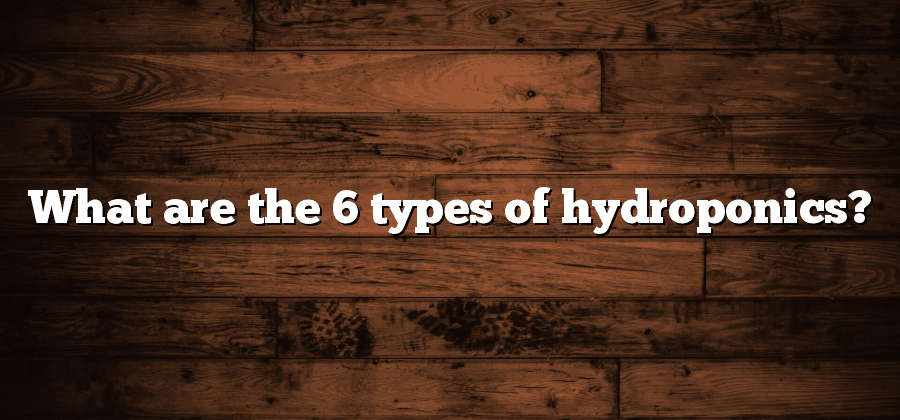Nutrient Film Technique (NFT) Hydroponics
Nutrient Film Technique (NFT) hydroponics is a popular and efficient method of growing plants without soil. In this system, a shallow, inclined channel is used to continuously circulate a thin film of nutrient-rich water over the plant roots. This allows the plants to take up water and nutrients as they need them, ensuring optimal growth and development.
One of the main advantages of NFT hydroponics is its water-saving capabilities. The continuous flow of water in the system means that plants receive only the amount of water they require, with very minimal wastage. This makes it an environmentally-friendly choice, especially in regions where water scarcity is a concern. Additionally, NFT hydroponics allows for better control over nutrient levels and pH, leading to healthier plants and higher crop yields.
Deep Water Culture (DWC) Hydroponics
Deep Water Culture (DWC) Hydroponics is a popular method of growing plants without soil. It involves suspending the plant roots in a nutrient-rich solution, allowing them to directly access the necessary water and nutrients. This system is particularly favored by hydroponic enthusiasts for its simplicity and effectiveness.
One of the key advantages of Deep Water Culture (DWC) Hydroponics is its ability to provide a constant supply of nutrients to the plants. The roots are constantly submerged in the nutrient solution, ensuring a consistent intake of essential elements. This promotes optimal growth and development, resulting in healthier and more productive plants. Additionally, the oxygen-rich environment created by the air pump helps to supply the roots with ample oxygen, further enhancing their growth potential.
Aeroponics Hydroponics: The Future of Agriculture
Aeroponics hydroponics is a cutting-edge method that holds promise as the future of agriculture. It utilizes a unique approach in which plants are grown in a mist environment, suspended in air, without the use of soil or traditional hydroponic mediums. This innovative technique offers numerous benefits, including enhanced nutrient uptake and efficient water usage.
One significant advantage of aeroponics hydroponics is its ability to deliver nutrients directly to the plant’s roots, promoting faster and healthier growth. This method uses misters or atomizers to create a fine mist that envelops the plant’s root system, allowing for optimal nutrient absorption. By providing a high level of oxygen to the roots, aeroponics creates an ideal environment for plants to thrive.
Furthermore, aeroponics hydroponics requires significantly less water compared to traditional soil-based farming methods. The precise control over water delivery and utilization in this technique helps conserve this invaluable resource, making it an environmentally friendly choice. Additionally, the absence of soil eliminates the risk of soil-borne diseases and pests, reducing the need for chemical pesticides and herbicides.
As scientists continue to refine and develop aeroponics hydroponics, its potential for revolutionizing agriculture becomes increasingly clear. With its ability to produce higher yields in a smaller space, conserve water, and avoid the use of harmful chemicals, this method offers hope for sustainable and efficient food production for a growing population. The future of agriculture may indeed lie in the mist-filled chambers of aeroponics hydroponics.
Drip Irrigation Hydroponics: Efficient Watering Solutions
Drip irrigation hydroponics is a highly efficient watering solution that is widely used in the field of hydroponic farming. This innovative method involves delivering nutrient-rich water directly to the plants’ roots, ensuring optimal absorption and minimizing water wastage. Unlike traditional soil-based agriculture, where water can easily evaporate or be absorbed by nearby plants, drip irrigation allows for precise control over water distribution, resulting in significant water savings.
One of the key advantages of drip irrigation hydroponics is its ability to reduce water consumption. By supplying water directly to the root zone, this method eliminates the risk of water evaporation and runoff, maximizing water usage. Additionally, the precise delivery of nutrients and water to the plants leads to healthier and more vigorous growth. The plants receive the exact amount of water and nutrients they need, resulting in improved yields and increased plant health. Furthermore, drip irrigation hydroponics promotes a more sustainable and environmentally friendly approach to agriculture by reducing the overall water footprint and minimizing the need for chemical fertilizers.
Wick System Hydroponics: A Simple Setup for Beginners
Wick System hydroponics is an ideal choice for beginners who are new to the world of hydroponic gardening. This simple setup requires minimal maintenance and is relatively easy to put together. With the wick system, there are no pumps or moving parts involved, making it a hassle-free option for those looking to start their hydroponic journey.
To set up a wick system, all you need is a container filled with a nutrient solution, a growing medium, and a wick that will transport the nutrients from the reservoir to the plants. The wick acts as a passive transport system, drawing up the nutrient solution and delivering it to the roots. This allows the plants to get the water and nutrients they need without the need for constant monitoring or adjustment.
One of the key advantages of the wick system is its simplicity. As a beginner, you don’t have to worry about complex equipment or sophisticated techniques. The wick system is easy to understand and straightforward to set up, making it a great starting point for anyone interested in hydroponics. It provides a low-cost and low-maintenance option that allows you to experiment and learn about hydroponic gardening without feeling overwhelmed or discouraged.






